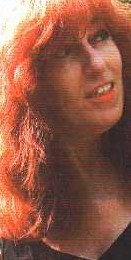VISIE IN UNDERGROUND MAGAZINE NEW YORK

INTERVIEW (Op virtueel) UNDERGROUND MAGAZINE NEW YORK
More grip on life by creating
Isis Nedloni is a Dutch female painting artist who also has some roots in the United States. In this article she tells about the impressions she got during her time in the USA and her special perception of making and observing the arts, influenced by her American roots.
‘In the fifties, I was born on a boat in Loenen aan de Vecht, a small (river) town near
Amsterdam, the Netherlands. I grew up in an artistic family with lots of stimulation for creativity. My grandfather was a water colour painter, his nephew a famous sculptor and my mother a great crayon artist. At the age of ten, I won a drawing contest and I loved to write small stories. Unfortunately, my father suffered a war trauma which influenced our lives. I was stuck in a stubborn puberty and dropped out of several schools. Therefore, I could not pass the school of art. I manufactured paintings and drawings, but felt kind of lost.
‘At the age of seventeen, I became pregnant of an American ex-Vietnam veteran, married and went to the States for two months. My husband Rick got very sick (cancer), so we stayed two years longer. Our beautiful son was born in Macomb, Illinois. While Rick was treated, he studied psychology at the university. He introduced me into the psychology of Freud and Jung which influenced me for the rest of my life. My drawing activity almost stood still in the USA.
‘In the States, I lived in a conservative area. I had the opinion the average American was pretty tasteless. The way they decorated their houses, the way they dressed. People looked and thought the same way, raised by too many indoctrinated rules. Everything in the average life seemed to be planned from birth until death. I found them also very chauvinistic with no particular interests in other parts of the world and missed the individual creativity or the authenticity from persons. I could not stand the racism or the tough society. But, I enjoyed the wide horizons and wild nature of the Mid-west. I loved the creative mind of Bob Dylan, Lou Reed, Jimmy Hendrix, Janis Joplin, Frank Zappa etc. I drank herb teas, smoked some marihuana, did read the Lord of the Rings, James Baldwin, Simone de Beauvoir, the philosophy of Sartre and the poetry of Oscar Wilde .
‘After returning to The Netherlands, I divorced. Later on I did have a relationship with the wrong man. My life got into a very difficult, sometimes hard and traumatic, negative spiral movement. Much (sexual) violence happened: Too many hard circumstances in which I had to survive and raise my son.
Later on, I managed to escape that life. My urge for painting came back and I started studying art therapy (bachelor-degree) in Nijmegen, which was a good combination with my work as a psycho-social worker.
‘From that moment, my art research and creative process started again. During that time, my obsession for all kinds of structure in my work and surroundings became stronger and stronger. I started to explore and experience my dark, vulnerable and traumatic parts, which can be expressed directly through different kinds of materials or through symbolism. During my study I learned about the iconology: a science that has an explanation for images, objects, the way of acting, symbolism of animals, persons etc. throughout history. I also learned about the creative world of the archetype (Jung) and the psycho-analysis (Freud).
‘In my profession the archetype is the symbol of an universal bridge from the sub-consciousness towards the consciousness. Through certain methods within art therapy you are able to get into contact with repressed emotions (conflicts). All over the world we find universal themes in our collective sub-consciousness: in men female parts (anima), in women the male part (animus), which are also hidden in the archetype symbolism. Through psycho-analytical perception an artist can express his or her desires and emotions: regression in favor of the ego. The artist can also project incoherent parts of himself into the work. By expressing fairy-tales, myths or legends, the artist canalises the chaos of the sub-consciousness. I look and work from this art perception and its expression. Because of this perception, I observe and experiment from another point of view then most people do.
‘I see lots of universal overlapping areas between my work and those of modern American artists (painters): archetype works with structures and symbolism are spread all over the world. Especially at this time, with so much global communication and mobility, I can not see any difference between American and European art. Archaic art and mythology capture ages of symbolism of the original fears and lust of men (or women). Our modern psychology discovered that this old symbolic ‘language’ still lives in our dreams, our language and art, in spite of all the changes we have gone through in our external way of life. America is a young country. Before the (mostly) Europeans captured the land, it belonged to the Indians. They also used archetype forms and we discover them in all of our old cultures.
During my study I also recognized my own post traumatic stress syndrome.(PTSS)
(Wordt vervolgt ,ZIE interview 2 INFO PAG.)
